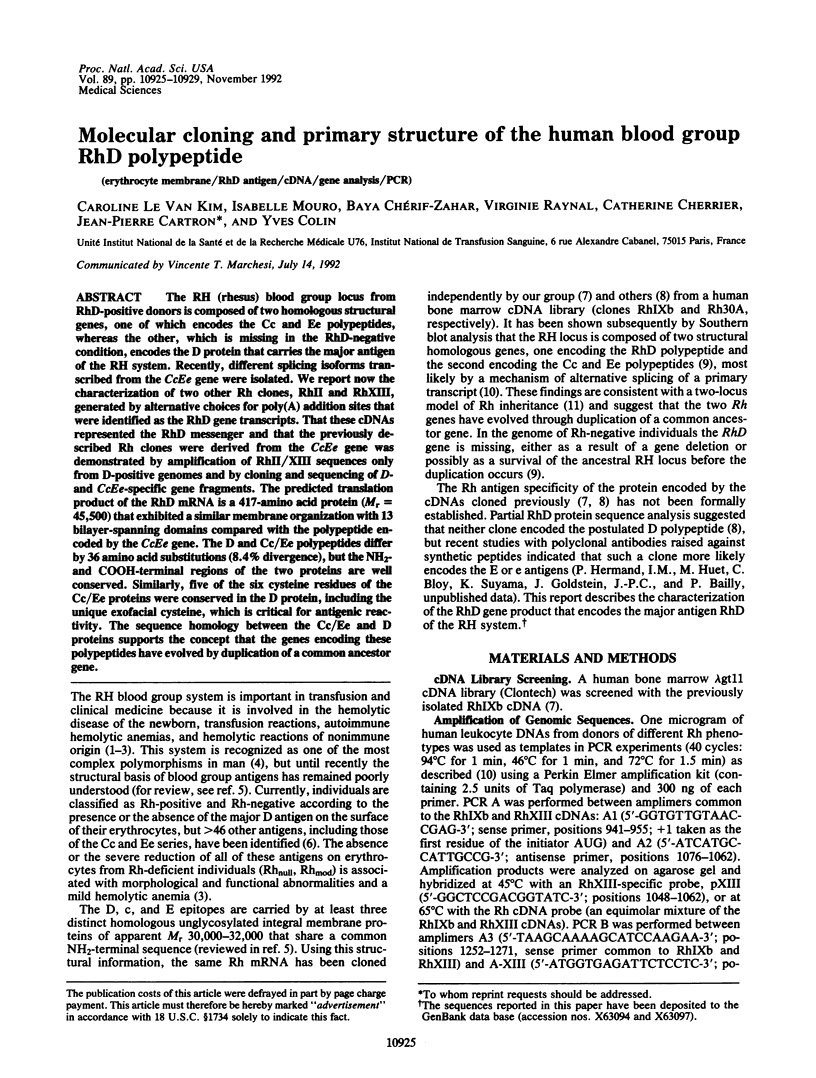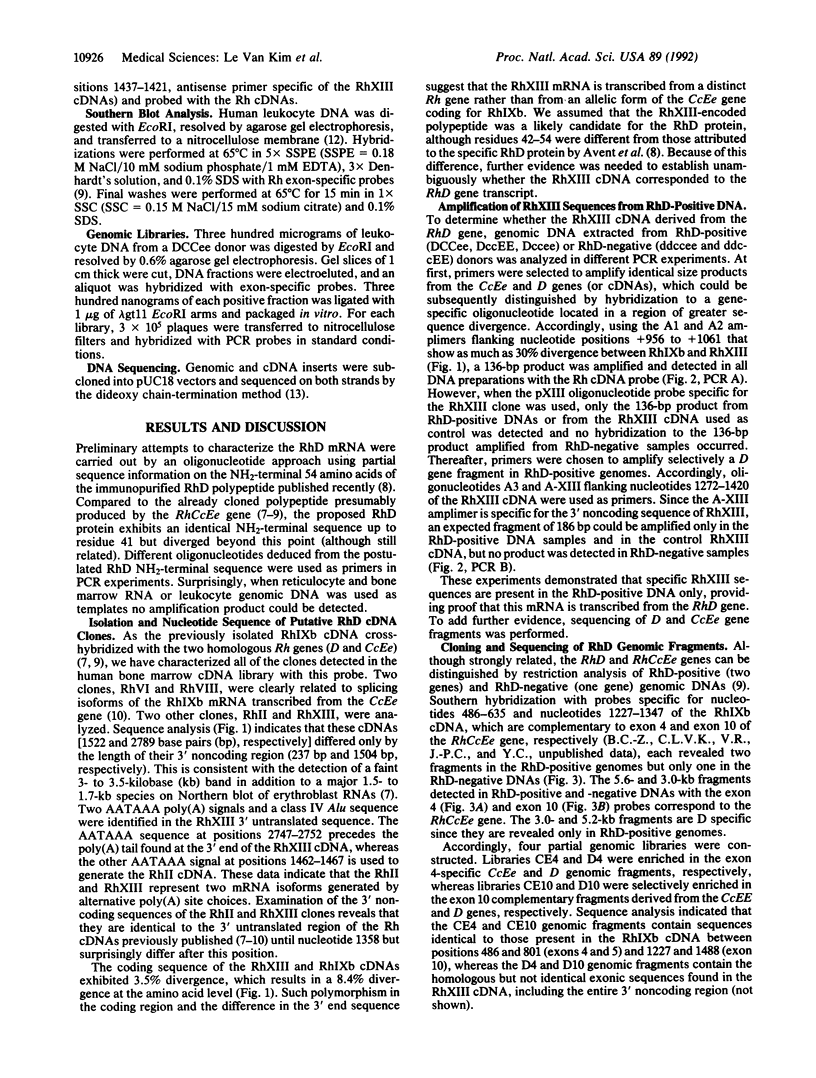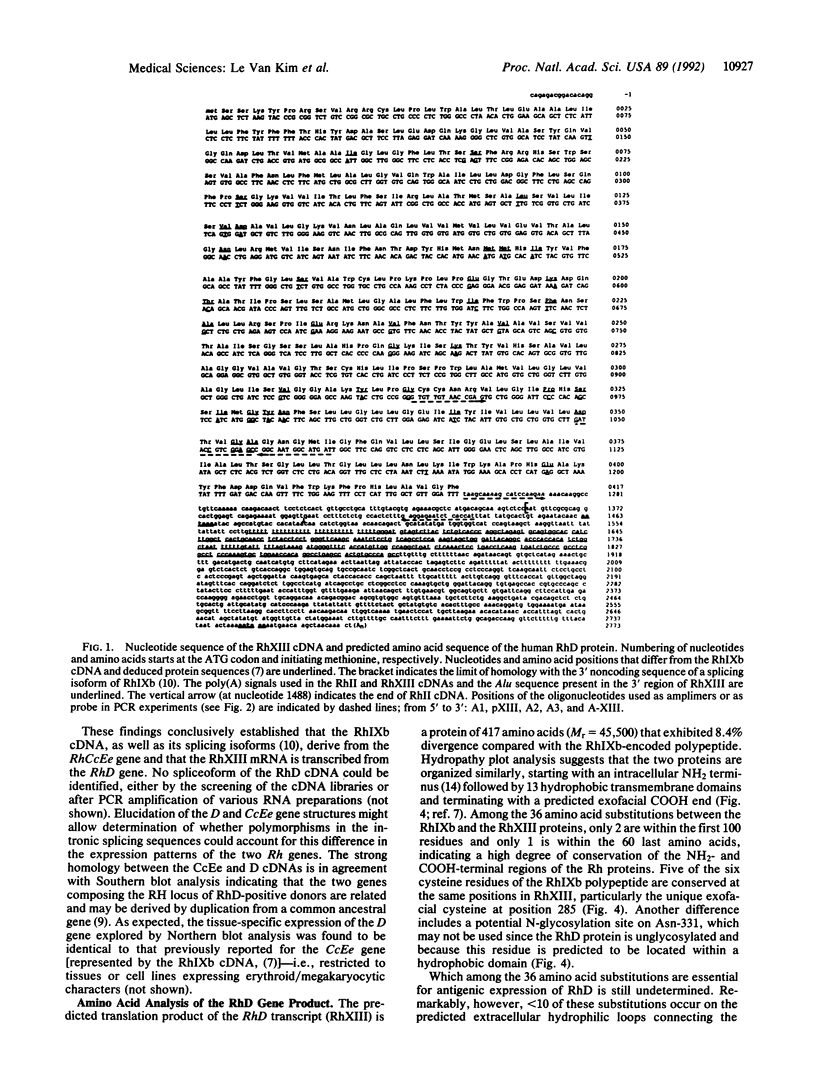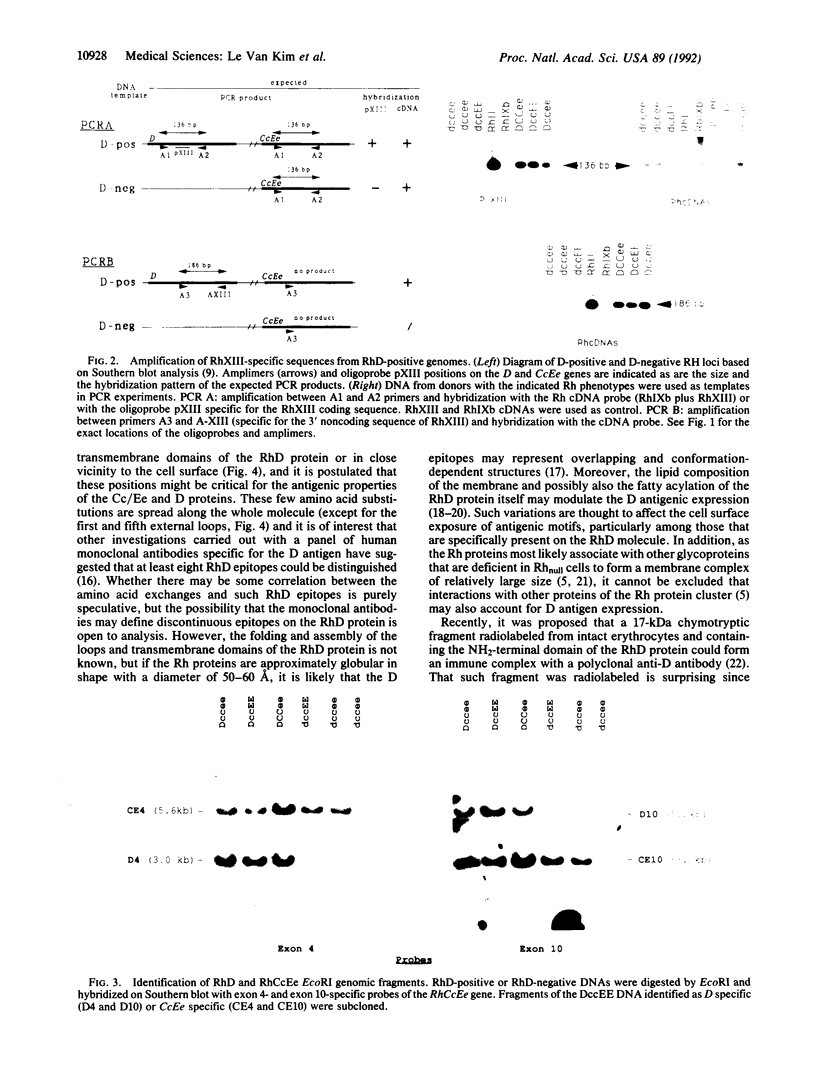Abstract
The RH (rhesus) blood group locus from RhD-positive donors is composed of two homologous structural genes, one of which encodes the Cc and Ee polypeptides, whereas the other, which is missing in the RhD-negative condition, encodes the D protein that carries the major antigen of the RH system. Recently, different splicing isoforms transcribed from the CcEe gene were isolated. We report now the characterization of two other Rh clones, RhII and RhXIII, generated by alternative choices for poly(A) addition sites that were identified as the RhD gene transcripts. That these cDNAs represented the RhD messenger and that the previously described Rh clones were derived from the CcEe gene was demonstrated by amplification of RhII/XIII sequences only from D-positive genomes and by cloning and sequencing of D- and CcEe-specific gene fragments. The predicted translation product of the RhD mRNA is a 417-amino acid protein (M(r) = 45,500) that exhibited a similar membrane organization with 13 bilayer-spanning domains compared with the polypeptide encoded by the CcEe gene. The D and Cc/Ee polypeptides differ by 36 amino acid substitutions (8.4% divergence), but the NH2- and COOH-terminal regions of the two proteins are well conserved. Similarly, five of the six cysteine residues of the Cc/Ee proteins were conserved in the D protein, including the unique exofacial cysteine, which is critical for antigenic reactivity. The sequence homology between the Cc/Ee and D proteins supports the concept that the genes encoding these polypeptides have evolved by duplication of a common ancestor gene.
Full text
PDF




Images in this article
Selected References
These references are in PubMed. This may not be the complete list of references from this article.
- Agre P., Cartron J. P. Molecular biology of the Rh antigens. Blood. 1991 Aug 1;78(3):551–563. [PubMed] [Google Scholar]
- Avent N. D., Ridgwell K., Tanner M. J., Anstee D. J. cDNA cloning of a 30 kDa erythrocyte membrane protein associated with Rh (Rhesus)-blood-group-antigen expression. Biochem J. 1990 Nov 1;271(3):821–825. doi: 10.1042/bj2710821. [DOI] [PMC free article] [PubMed] [Google Scholar]
- Blanchard D., Bloy C., Hermand P., Cartron J. P., Saboori A. M., Smith B. L., Agre P. Two-dimensional iodopeptide mapping demonstrates that erythrocyte Rh D, c, and E polypeptides are structurally homologous but nonidentical. Blood. 1988 Oct;72(4):1424–1427. [PubMed] [Google Scholar]
- Bloy C., Hermand P., Blanchard D., Cherif-Zahar B., Goossens D., Cartron J. P. Surface orientation and antigen properties of Rh and LW polypeptides of the human erythrocyte membrane. J Biol Chem. 1990 Dec 15;265(35):21482–21487. [PubMed] [Google Scholar]
- Chérif-Zahar B., Bloy C., Le Van Kim C., Blanchard D., Bailly P., Hermand P., Salmon C., Cartron J. P., Colin Y. Molecular cloning and protein structure of a human blood group Rh polypeptide. Proc Natl Acad Sci U S A. 1990 Aug;87(16):6243–6247. doi: 10.1073/pnas.87.16.6243. [DOI] [PMC free article] [PubMed] [Google Scholar]
- Colin Y., Chérif-Zahar B., Le Van Kim C., Raynal V., Van Huffel V., Cartron J. P. Genetic basis of the RhD-positive and RhD-negative blood group polymorphism as determined by Southern analysis. Blood. 1991 Nov 15;78(10):2747–2752. [PubMed] [Google Scholar]
- Engelman D. M., Steitz T. A., Goldman A. Identifying nonpolar transbilayer helices in amino acid sequences of membrane proteins. Annu Rev Biophys Biophys Chem. 1986;15:321–353. doi: 10.1146/annurev.bb.15.060186.001541. [DOI] [PubMed] [Google Scholar]
- Hartel-Schenk S., Agre P. Mammalian red cell membrane Rh polypeptides are selectively palmitoylated subunits of a macromolecular complex. J Biol Chem. 1992 Mar 15;267(8):5569–5574. [PubMed] [Google Scholar]
- Hughes-Jones N. C., Gorick B. D., Brown D. Differential exposure of epitopes on the human red cell antigen D (Rh). Immunol Lett. 1991 Feb;27(2):101–103. doi: 10.1016/0165-2478(91)90135-w. [DOI] [PubMed] [Google Scholar]
- Krahmer M., Prohaska R. Characterization of human red cell Rh (rhesus-)specific polypeptides by limited proteolysis. FEBS Lett. 1987 Dec 21;226(1):105–108. doi: 10.1016/0014-5793(87)80560-4. [DOI] [PubMed] [Google Scholar]
- Le Van Kim C., Chérif-Zahar B., Raynal V., Mouro I., Lopez M., Cartron J. P., Colin Y. Multiple Rh messenger RNA isoforms are produced by alternative splicing. Blood. 1992 Aug 15;80(4):1074–1078. [PubMed] [Google Scholar]
- Lomas C., Tippett P., Thompson K. M., Melamed M. D., Hughes-Jones N. C. Demonstration of seven epitopes on the Rh antigen D using human monoclonal anti-D antibodies and red cells from D categories. Vox Sang. 1989;57(4):261–264. doi: 10.1111/j.1423-0410.1989.tb00839.x. [DOI] [PubMed] [Google Scholar]
- Nash R., Shojania A. M. Hematological aspect of Rh deficiency syndrome: a case report and a review of the literature. Am J Hematol. 1987 Mar;24(3):267–275. doi: 10.1002/ajh.2830240306. [DOI] [PubMed] [Google Scholar]
- Sanger F., Nicklen S., Coulson A. R. DNA sequencing with chain-terminating inhibitors. Proc Natl Acad Sci U S A. 1977 Dec;74(12):5463–5467. doi: 10.1073/pnas.74.12.5463. [DOI] [PMC free article] [PubMed] [Google Scholar]
- Shinitzky M., Souroujon M. Passive modulation of blood-group antigens. Proc Natl Acad Sci U S A. 1979 Sep;76(9):4438–4440. doi: 10.1073/pnas.76.9.4438. [DOI] [PMC free article] [PubMed] [Google Scholar]
- Southern E. M. Detection of specific sequences among DNA fragments separated by gel electrophoresis. J Mol Biol. 1975 Nov 5;98(3):503–517. doi: 10.1016/s0022-2836(75)80083-0. [DOI] [PubMed] [Google Scholar]
- Suyama K., Goldstein J. Membrane orientation of Rh(D) polypeptide and partial localization of its epitope-containing domain. Blood. 1992 Feb 1;79(3):808–812. [PubMed] [Google Scholar]
- Tippett P. A speculative model for the Rh blood groups. Ann Hum Genet. 1986 Jul;50(Pt 3):241–247. doi: 10.1111/j.1469-1809.1986.tb01045.x. [DOI] [PubMed] [Google Scholar]
- Tippett P. Serologically defined Rh determinants. J Immunogenet. 1990 Aug-Oct;17(4-5):247–257. doi: 10.1111/j.1744-313x.1990.tb00878.x. [DOI] [PubMed] [Google Scholar]





